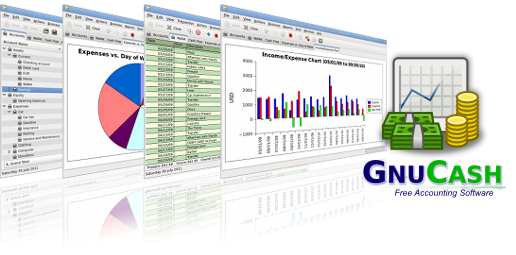


#Gnucash import manual#

File import menu items for the MT940, MT942, and DTAUS formats is replaced with a single Import from AQBanking that supports importing any file format supported by AQBanking, including the frequently requested CAMT.The description field quickfill in the register now displays a drop-down list of possible completions instead of just one inline completion.If you set a high or low limit and the account balance falls above or below the respective limit an indicator will be shown in the Balance Limit column. That's coupled to a new column that's available on the Accounts Page, Balance Limit. A new tab on the New/Edit Account dialog called More Properties includes entries to set a high and low limit on an account.Use Reports>Assets & Liabilities>Investment Lots to see the report. Note that if you don't use the View Lots dialog to manage capital gains and losses this report won't have anything to show you. A new Investment Lots report showing a graph of capital gains and losses in a period by investment lot.You can access it from Actions>Stock Assistant when you have the Accounts page ora Stock or Fund account register open. A new Stock Transaction Assistant to guide you through entering most investment transactions for stocks, bonds, and mutual funds.Do not use it with production data! Make a copy of your book to test this release. This is an unstable release for testing purposes. Implement thread.The GnuCash development team announces GnuCash 4.901, the second unstable release leading to GnuCash 5.0.Data Science vs Big Data vs Data Analytics.CommitEdit () # Finish editing transaction SetMemo ( "Other Split Memo!" ) # optional SetAccount ( lookup_account ( root, "Assets:Current Assets:Checking" )) Sp2 = Split ( book ) # Need a balancing split SetValue ( GncNumeric ( amount, 100 )) # Assuming you only have one split # For multiple splits, you need to make sure the totals all balance out. SetAccount ( lookup_account ( root, "Expenses:Some Expense Account" )) # amount is an int (no $ or. SetParent ( tx ) # The lookup string needs to match your account path exactly. Sp1 = Split ( book ) # First half of transaction SetDescription ( "Transaction Description!" ) #tx.SetNum(int_variable) # if you need a transaction number SetDatePostedTS ( today ) # or another datetime object for the transaction's "register date" get_root_account () # Parent of all accountsĬurrency = book. book # All actions are performed through the book object (or its children) Session = Session ( "/path/to/file.gnucash" ) #, ignore_lock=True) # or use URI string: = datetime. split ( ':' ) return lookup_account_by_path ( root, path ) join ( path ))) if len ( path ) > 1 : return lookup_account_by_path ( acc, path ) return acc get_instance () = None : raise Exception ( 'Account path not found'. from gnucash import Session, Account, Transaction, Split, GncNumeric import gnucashĭef lookup_account_by_path ( parent, path ):Īcc = parent. Then just call the transaction function from your email listener, and you should be in business.
#Gnucash import code#
You can place all of the transaction code into a function, then hand in whatever data you need to create the two custom transactions. Here's a template, along with a couple of account lookup functions which are sorely lacking in the library.


 0 kommentar(er)
0 kommentar(er)
